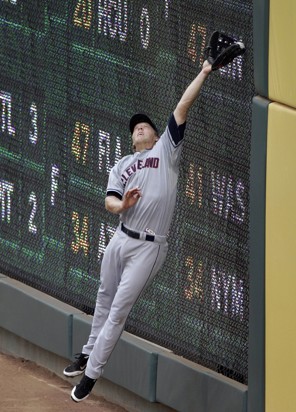 Indians Archive
Indians Archive  View from the Porch: An Experiment in Failure
View from the Porch: An Experiment in Failure
 Baseball is a combination of sciences. It’s a game made up of angles and formulas, psyches and confidence, and experiments. Players experiment with new things all the time. A change in mechanics, a heavier bat, a different timing mechanism in the batter’s box. Managers experiment as well. They change up the batting order. They use a different guy in the seventh inning than they did the night before. They test their starter’s mettle by sending him back out for another inning with a pitch count well over 100.
Baseball is a combination of sciences. It’s a game made up of angles and formulas, psyches and confidence, and experiments. Players experiment with new things all the time. A change in mechanics, a heavier bat, a different timing mechanism in the batter’s box. Managers experiment as well. They change up the batting order. They use a different guy in the seventh inning than they did the night before. They test their starter’s mettle by sending him back out for another inning with a pitch count well over 100.
Front offices experiment too. Every front office has to operate in a unique way, whether it has to deal with payroll constraints, an undesirable geographic location, or hypothesize a player’s production based on a series of calculations. The Indians front office has all three of those things going at any given time on any given player. Considered one of the most progressive front offices in baseball in terms of statistical analysis, the Indians are always looking for any edge that they can find that will fit into their payroll constraints.
Every front office experiment is scrutinized in the public eye. Joe Average Fan doesn’t really pay much attention to player experiments, which are, more accurately, “adjustments”. Joe Average Fan doesn’t really notice when a hitter changes something about his stride or when a fielder starts playing two steps to the left because he has found that he has more trouble going to that side.
The current Indians roster features a handful of experiments. Some have gone extremely well and others that have gone extremely poorly. The front office is forced to be creative and try to do whatever they can to maximize a player’s value because they can’t go fill holes in free agency. Most experiments are position changes, like Jason Kipnis’s move to second base after being drafted as an outfielder. Other experiments put starters in relief roles, for any number of reasons.
There are very few certainties in the game of baseball. Remember the acronym TINSTAAPP? There is no such thing as a pitching prospect. Roughly one out of every ten players signed to a contract as a prospect will actually make it to the bigs. That doesn’t mean make it as an impactful player. That means appear in a Major League game period.
The Indians are dealing with two failed experiments right now that are severely hampering the ballclub. Often times, when one thing fails, another uncertainty enters the picture.
 When departing from Goodyear, AZ, the Indians decided that Shelley Duncan would be capable of seeing 500 at bats as the everyday left fielder. Consider that, in 2010, Shelley Duncan had 229 at bats. In his previous three years in the Majors, Duncan had 146 at bats. Duncan played in 76 games in 2011 and hit a respectable .260, due in large part to a very good September where he hit seven home runs and had a .943 OPS.
When departing from Goodyear, AZ, the Indians decided that Shelley Duncan would be capable of seeing 500 at bats as the everyday left fielder. Consider that, in 2010, Shelley Duncan had 229 at bats. In his previous three years in the Majors, Duncan had 146 at bats. Duncan played in 76 games in 2011 and hit a respectable .260, due in large part to a very good September where he hit seven home runs and had a .943 OPS.
The Indians were willing to see how the process would go. They already knew that Duncan was a defensive liability who struggled against right handed pitching and had never been an everyday player in the Majors.
Through April 17, the Indians front office looked like a collection of geniuses. Duncan’s defense had not been an issue and he had posted a slash line of .333/.514/.593/1.106. Off the chart numbers. Since that time, Duncan has gone 8-for-53. By no means is Duncan as bad as a .151 hitter. He’s also not a .333 hitter. He’s probably a combination of the two, which is a .242 hitter. His career average is .236.
Even though Duncan had been playing well, Michael Brantley was hitting .205 with a .612 OPS. Duncan was the chief concern of the outfield entering the season, but by mid-April, Brantley had become an issue. The Indians, desperate for outfield help wherever they could find it because they lost out on free agents Josh Willingham, Carlos Beltran, Michael Cuddyer, and Jason Kubel, showed interest in Johnny Damon.
Damon, who had played just over 50 games in the outfield over the last two seasons, was sitting out on the free agent market. The Indians really hadn’t come to a conclusion with their Duncan experiment, but felt like taking their chances with Damon.
To say that the Johnny Damon experiment has failed is an understatement.
Damon has come as advertised defensively. He is running terrible routes, has the arm of a kindergartner, and has looked like the 38-year-old that he is. The Indians knew that they were getting a bad outfielder. What they didn’t plan for in their experiment is that Damon would be hitting .171 through his first 41 at bats and look really awful in the process. From my recollection, Damon has hit exactly one ball hard, and it went over the centerfielder’s head for a two-run triple. Everything else has been slapped to the left side or popped up on the infield.
This is one instance where the eye test is far more telling than the stats. Damon hasn’t even looked like a .170 hitter. Hell, he’d probably hit a pop up if he was swinging off a tee. Unfortunately, because the Indians tried and failed (and I’ll give them credit, they tried very hard for Beltran and Willingham) with the free agent options, the cord won’t be cut from Damon anytime soon. I’ve begun referring to him as DFAmon in hopes that he’ll be designated for assignment, but that’s mostly in jest because if I took it seriously, I’d be disappointed every day.
Standing on the Home Run Porch, I have one of the best views of Johnny Damon. For whatever reason, the fans in the bleachers and down the left field line love him and have yelled for him every chance they’ve gotten. Furthermore, Damon has spent more time acknowledging the cheers than he has working on getting hits and fielding.
 Enter experiment Number Two. The man who I’m currently watching pitch. Ubaldo Jimenez. The Indians shocked a lot of people when they seriously considered trading top prospect Drew Pomeranz and hard-throwing righty Alex White for Ubaldo Jimenez. Jimenez definitely showed his potential in 2010, but had a rough start to 2011 and had become disgruntled in Colorado. It wasn’t the Indians modus operandi to be a buyer, let alone one that traded top prospects to acquire players. In the Cleveland market, having a player under control for six years as a club-friendly price tag superseded any proven talent with an escalating contract.
Enter experiment Number Two. The man who I’m currently watching pitch. Ubaldo Jimenez. The Indians shocked a lot of people when they seriously considered trading top prospect Drew Pomeranz and hard-throwing righty Alex White for Ubaldo Jimenez. Jimenez definitely showed his potential in 2010, but had a rough start to 2011 and had become disgruntled in Colorado. It wasn’t the Indians modus operandi to be a buyer, let alone one that traded top prospects to acquire players. In the Cleveland market, having a player under control for six years as a club-friendly price tag superseded any proven talent with an escalating contract.
Alas, the Jimenez trade was made and met with very mixed emotions. As Ubaldo Jimenez leaves this latest start in the fifth inning allowing 14 baserunners in 4.1 innings, people couldn’t hate the deal more. Jimenez is an absolute mess mechanically and has been for quite some time. The Indians took a shot and, so far, missed. They have experimented numerous times with changes to Jimenez’s windup and delivery, but to no avail.
Jimenez came off as confrontational and arrogant in Spring Training when Manager Manny Acta questioned him about his struggles. I can’t imagine the Indians planned for that when assessing the potential outcome of their trade. They just assumed that his discontent was a result of falling out of favor with the Rockies front office. Turns out that it’s probably more than that and that Jimenez is a bit of an emotional basketcase.
Some experiments work out well. The Indians milked the last decent production out of Orlando Cabrera in 2011, got tremendous results with Kevin Millwood in 2005, have gotten solid returns on moving Jason Kipnis to second base, seem to be getting a lot more than they expected from Jack Hannahan, and have gotten pretty good numbers by keeping Justin Masterson in the rotation.
Everybody remembers the failed experiments and that’s what Jimenez and Damon appear to be. People still remember the disaster that was Kerry Wood in 2010. They still refer to Trot Nixon, who was a phenomenal teammate and a key part of the 2007 run, but was a stiff when it came to on-field contributions. David Dellucci was an epic fail.
In this market, with this ownership group, the Indians will have to continue to experiment with creative ways to field a competitive ballclub. Some things will work out. Others won’t. And others turn out like Ubaldo Jimenez and Johnny Damon.
- NBA Announces 2013-2014 Schedule
- Browns Ink Sharknado
- Sharknado A No-Show For Rookie Camp
- Trent Richardson Out Until Training Camp
- Browns Sign Brandon Jackson
- Carrasco Suspended Eight Games
- Browns Add to Wide Receiver Depth with David Nelson
- Browns Need to Learn from Past Draft Mistakes
- Browns Release Chris Gocong and Usama Young
- Browns Missing on Grimes Disappointing, But Not The End
The TCF Forums
- Chris Grant's first 3 drafts
Kingpin74 (Tuesday, January 21 2014 10:13 AM) - The 2014 Offseason Thread
googleeph2 (Tuesday, January 21 2014 9:36 AM) - 2015 Recruiting
furls (Tuesday, January 21 2014 6:57 AM) - Mike Brown
YahooFanChicago (Monday, January 20 2014 11:15 PM) - Movies coming out
HoodooMan (Monday, January 20 2014 9:34 PM) - 2014 Hoops Hockey Hijinx
jpd1224 (Monday, January 20 2014 4:44 PM) - 2014 Recruiting
jclvd_23 (Monday, January 20 2014 2:26 PM) - Wish List - #4 Pick
Hikohadon (Monday, January 20 2014 1:26 PM) - Official- Browns Coach Search/Rumors
OldDawg (Sunday, January 19 2014 6:48 PM) - #1 overall pick Anthony Bennett
TouchEmAllTime (Sunday, January 19 2014 1:28 PM)



